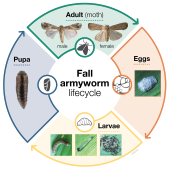Fall armyworm
Fall armyworm
Fall armyworm (FAW), Spodoptera frugiperda, arrived on mainland Australia in February 2020.
Since then, FAW has established populations in northern areas of Queensland, the Northern Territory and Western Australia. The movement of FAW is being monitored with movement into more southerly areas expected during warmer months through spring, summer and autumn.
Early indications are that maize and sorghum broadacre crops are a preferred food source for FAW, but it has also been found in some pulses. Potential impacts of FAW on crops grown in more southerly areas and its seasonal migratory range are not yet fully understood.
Growers and advisers should monitor industry updates on the migratory movement of FAW. Regular monitoring of crops to identify signs of early FAW infestation and implementing approved control measures is the best way of minimising economic losses caused by this pest.
This portal provides access to important information for Australian grain growers, including the national Fall Armyworm Continuity Plan – a reference document that consolidates information about FAW and its management in grain crops.
-

09 Feb 2024, Growers on alert for Fall armyworm
Fall armyworm (FAW) are being detected at unprecedented levels in sorghum crops across Central Queensland, the Western and Darling Downs and northern New South Wales.
-

04 Sept 2022, Fall armyworm steps and lessons
The arrival of fall armyworm (FAW) in 2020 is a timely illustration of the importance of being forewarned and forearmed.
-

04 Sep 2022, What happens in a pest incursion?
Have you ever wondered what goes on behind the scenes of biosecurity when a new pest is found in Australia?
-

04 Sep 2022, Multi-crop pests tackled on a coordinated front
Many pests can damage multiple crops across multiple industries, necessitating a coordinated, national approach to control measures and research.
-

28 May 2021, What happens when an exotic pest arrives in Australia?
An important part of Australia’s biosecurity system is to prepare for the arrival of exotic pests.
-

22 Mar 2021, Differences in insecticide sensitivity shown in fall armyworm
New research indicates there are variable levels of sensitivity to some insecticides between populations of fall armyworm in different geographical areas of Australia.





















